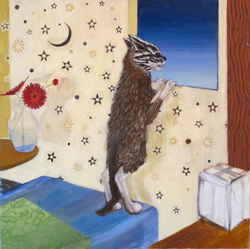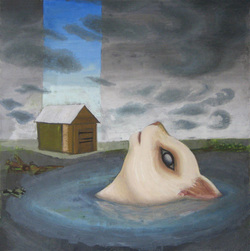I just finished reading The Complete Stories and Parables by Kafka. A couple of things struck me.
First of all, Kafka – at least in his short works, perhaps not so much in his novels – is a surrealist. The word, surreal, is often used to describe the situations that Kafka’s characters find themselves in. and in common parlance, “Kafkaesque” has become a synonym for “surreal.” But Kafka, himself, is not thought of as a surrealist writer.
Perhaps that is because “surrealist literature” usually is represented by writers who were actively involved in the French surrealist movement – Breton, of course, Apollinaire, Jarry, Daumal, et. al. – and their contemporary successors, Queneau and the Oulipo cohort.
The surrealism of the early group of writers amounted to the juxtaposition of ordinarily incompatible images and ideas, often said to be the result of automatic writing, although Breton eventually fessed up to having carefully thought out works he initially presented as automatic.
Today’s Wikipedia puts it quite well:
[Early surrealists’ writings] showed their disdain for literal meanings given to objects and focused rather on the undertones, the poetic undercurrents present. Not only did they give emphasis to the poetic undercurrents, but also to the connotations and the overtones which ‘exist in ambiguous relationships to the visual images.’
Because Surrealist writers seldom, if ever, appear to organize their thoughts and the images they present, some people find much of their work difficult to parse.
Kafka’s work, of course, is quite easily parsed – and is all the more disturbing because of it. But the world he describes so lucidly – with the careful, detailed realism of Magritte, let’s say – is classically surreal.
A man-sized cockroach awkwardly stands before a window looking longingly down at the life on the street below.
A maid busily cleans a bedroom, while a giant cockroach peeks out at her from under a dresser.
Three boarders (one can almost imagine them wearing Magritte-like derbies) listen, with increasing annoyance, to their landlord’s daughter’s unskilled performance on the violin, while a giant cockroach edges its way through a doorway so it too can listen.
And those images are just from Metamorphosis. Here are some more, from other stories of Kafka’s.
Condemned criminals are punished by being strapped down in a complicated apparatus which incises written descriptions of their crimes on their naked bodies. (The Penal Colony)
A village schoolmaster feels misused by the academic community because his essay on a giant mole, seen in the village, has not brought him the renown he expected. (The Village Schoolmaster)
A bourgeois bachelor is persecuted by a pair of bouncing balls. (Blumfeld, an Elderly Bachelor)
An artist, whose métier is starving himself, achieves fame and fortune. Later, as the fickle public moves on to other things, he ends up in a cage in a carnival, where his starving of himself, which he has brought to perfection, is ignored by a public more interested in seeing the exotic animals. (The Hunger Artist)


(There is a free on-line translation of Josephine, but it has some problems – particularly the description of Josephine’s singing, which is the same sound as that made by all the mice, as “whistling.” The translation by the Muirs – who were Max Brod’s choice for translating Kafka into English – uses the word “piping,” which is the probably the best choice among the few synonyms the thesaurus gives for “squeaking.”

 RSS Feed
RSS Feed